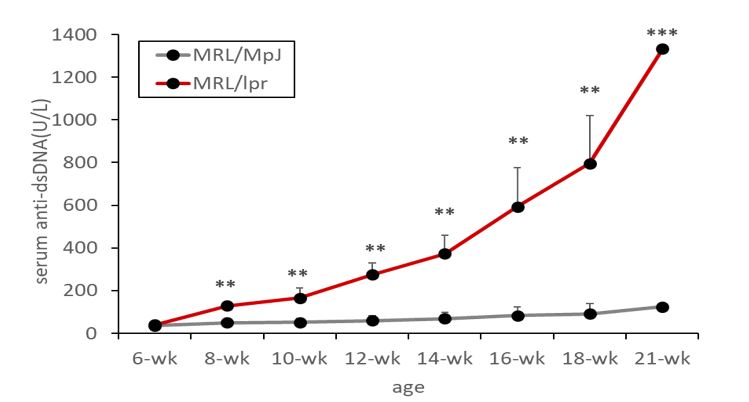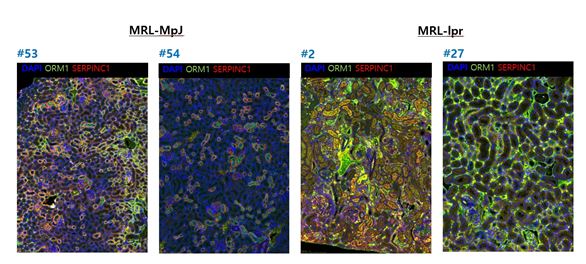Back
Poster Session A
Systemic lupus erythematosus (SLE)
Session: (0317–0342) SLE – Diagnosis, Manifestations, and Outcomes Poster I: Diagnosis
0341: Clinical Applications of Urine SERPINC1/ORM1 in MRL-lpr Lupus Nephritis-Prone Mice
Saturday, November 12, 2022
1:00 PM – 3:00 PM Eastern Time
Location: Virtual Poster Hall
- YK
YoungEun Kim, MD
Department of Rheumatology, Asan Medical Center, University of Ulsan College of Medicine, Seoul, Republic of Korea
Seoul, South Korea
Abstract Poster Presenter(s)
YoungEun Kim1, Eun-Ju Lee1, Soo Min Ahn1, Ji Seon Oh2, Seokchan Hong1, Chang Keun Lee1, Bin Yoo1 and Yong Gil Kim1, 1Department of Rheumatology, Asan Medical Center, University of Ulsan College of Medicine, Seoul, Republic of Korea, Seoul, Republic of Korea, 2Department of Information Medicine, Big Data Research Center, Asan Medical Center, Seoul, Republic of Korea
Background/Purpose: Despite improvements in the treatment of lupus nephritis (LN), the prognosis remains unsatisfactory, and a need for non-invasive biomarkers for early detection endures. Previously, the usefulness of Serpin peptidase inhibitor clade C (antithrombin) member 1 (SERPINC1) and alpha-1-acid glycoprotein (ORM1) have been proposed as urine biomarkers for LN diagnosis through proteomics studies. However, their usefulness at the early disease stage has not yet been elucidated.
This study investigated the utility of urine SERPINC1 and ORM1 as early biomarkers for LN in the MRL-lpr mice, murine models of LN.
Methods: Urine samples were collected from MRL-lpr and MRL/MpJ mice at ages 13 and 23 weeks. Urine SERPINC1, ORM1, creatinine, and albumin were analyzed using an enzyme-linked immunosorbent assay (ELISA). Levels of urine SERPINC1, ORM1, and albumin were corrected with creatinine concentration. Kidney biopsies of both sets of mice at 23 weeks were performed, and expression of ORM1 and SERPINC1 in kidney tissues was determined by opal multiplexed immunofluorescent staining. The activity and chronicity in kidney pathology were measured by an animal pathologist.
Results: A total of twenty-three of MRL-lpr (n=12) and MRL/MpJ (n=11) mice underwent analysis. Serum anti-dsDNA increased significantly in MRL-lpr mice according to the number of weeks compared with MRL-MpJ mice (Figure 1). The amount of urine SERPINC1 and ORM1 detected by ELISA was significantly higher in MRL-lpr mice than in MRL/MpJ mice at 13 and 23 weeks (SERPINC1: p< .01 and p< .001 at 13 and 23 weeks, respectively; ORM1: p< .01 at 13 and 23 weeks) (Figure 2). In contrast, no significant difference in urine albumin was observed between the two groups at 13 weeks (p=.83); however, a difference was detected at 23 weeks (p< .001). Regarding the kidney pathology of MPL-lpr mice, urine ORM1 had a significantly positive correlation with the activity index (rho =.879, p< .001) and chronicity index (rho =.947, p< .001). The correlation with the histopathology index was stronger than with urine albumin, the activity index (rho =.807, p=.003), and the chronicity index (rho =.869, p=< .001). SERPINC1 and ORM1 were primarily expressed in the tubular membrane in immunofluorescent-stained kidney tissue (Figure 3).
Conclusion: Urine SERPINC1 and ORM1 were detected in the LN murine model earlier than albumin. Additionally, urine ORM1 correlated with the degree of activity and chronicity index more than urine albumin. Therefore, we suggest urine SERPINC1 and ORM1 as novel biomarkers for early LN.
 Analysis of serum anti-dsDNA levels in mice
Analysis of serum anti-dsDNA levels in mice
.jpg) Comparative analysis of urine SERPINC1 and ORM1, and albumin level (A) urine SERPINC1 (B) urine ORM1 (C) urine albumin
Comparative analysis of urine SERPINC1 and ORM1, and albumin level (A) urine SERPINC1 (B) urine ORM1 (C) urine albumin
 Opal multiplexed immunofluorescent images; the expression of SERPINC1 and ORM1 in kidney tissue
Opal multiplexed immunofluorescent images; the expression of SERPINC1 and ORM1 in kidney tissue
Disclosures: Y. Kim, None; E. Lee, None; S. Ahn, None; J. Oh, None; S. Hong, None; C. Lee, None; B. Yoo, None; Y. Kim, None.
Background/Purpose: Despite improvements in the treatment of lupus nephritis (LN), the prognosis remains unsatisfactory, and a need for non-invasive biomarkers for early detection endures. Previously, the usefulness of Serpin peptidase inhibitor clade C (antithrombin) member 1 (SERPINC1) and alpha-1-acid glycoprotein (ORM1) have been proposed as urine biomarkers for LN diagnosis through proteomics studies. However, their usefulness at the early disease stage has not yet been elucidated.
This study investigated the utility of urine SERPINC1 and ORM1 as early biomarkers for LN in the MRL-lpr mice, murine models of LN.
Methods: Urine samples were collected from MRL-lpr and MRL/MpJ mice at ages 13 and 23 weeks. Urine SERPINC1, ORM1, creatinine, and albumin were analyzed using an enzyme-linked immunosorbent assay (ELISA). Levels of urine SERPINC1, ORM1, and albumin were corrected with creatinine concentration. Kidney biopsies of both sets of mice at 23 weeks were performed, and expression of ORM1 and SERPINC1 in kidney tissues was determined by opal multiplexed immunofluorescent staining. The activity and chronicity in kidney pathology were measured by an animal pathologist.
Results: A total of twenty-three of MRL-lpr (n=12) and MRL/MpJ (n=11) mice underwent analysis. Serum anti-dsDNA increased significantly in MRL-lpr mice according to the number of weeks compared with MRL-MpJ mice (Figure 1). The amount of urine SERPINC1 and ORM1 detected by ELISA was significantly higher in MRL-lpr mice than in MRL/MpJ mice at 13 and 23 weeks (SERPINC1: p< .01 and p< .001 at 13 and 23 weeks, respectively; ORM1: p< .01 at 13 and 23 weeks) (Figure 2). In contrast, no significant difference in urine albumin was observed between the two groups at 13 weeks (p=.83); however, a difference was detected at 23 weeks (p< .001). Regarding the kidney pathology of MPL-lpr mice, urine ORM1 had a significantly positive correlation with the activity index (rho =.879, p< .001) and chronicity index (rho =.947, p< .001). The correlation with the histopathology index was stronger than with urine albumin, the activity index (rho =.807, p=.003), and the chronicity index (rho =.869, p=< .001). SERPINC1 and ORM1 were primarily expressed in the tubular membrane in immunofluorescent-stained kidney tissue (Figure 3).
Conclusion: Urine SERPINC1 and ORM1 were detected in the LN murine model earlier than albumin. Additionally, urine ORM1 correlated with the degree of activity and chronicity index more than urine albumin. Therefore, we suggest urine SERPINC1 and ORM1 as novel biomarkers for early LN.
 Analysis of serum anti-dsDNA levels in mice
Analysis of serum anti-dsDNA levels in mice.jpg) Comparative analysis of urine SERPINC1 and ORM1, and albumin level (A) urine SERPINC1 (B) urine ORM1 (C) urine albumin
Comparative analysis of urine SERPINC1 and ORM1, and albumin level (A) urine SERPINC1 (B) urine ORM1 (C) urine albumin Opal multiplexed immunofluorescent images; the expression of SERPINC1 and ORM1 in kidney tissue
Opal multiplexed immunofluorescent images; the expression of SERPINC1 and ORM1 in kidney tissueDisclosures: Y. Kim, None; E. Lee, None; S. Ahn, None; J. Oh, None; S. Hong, None; C. Lee, None; B. Yoo, None; Y. Kim, None.

